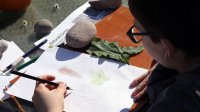Simple Ways to Bring Learning Outside
Going outside helps students focus, and activities for classes from social studies to math can incorporate the natural world.
Contemporary research reveals that spending time in nature has tremendous benefits for young people. They are better able to focus in natural settings, and studies show that physical activity, especially outside, improves academic readiness and both verbal and mathematical ability. As Richard Louv points out, “Time in nature is not leisure time; it’s an essential investment in our children’s health.” And going outside is free.
Below are several ideas for taking advantage of outside spaces.
Social Studies
Living history: Often, our own backyards are interesting examples of living history. Where did the plants, animals, and rocks in our backyards and parks come from? If they’re nonnative, when were they brought, and by whom?
Chalk footprints: Get some chalk and head outside. Encourage your students to draw outlines of buildings, towns, and cities. Create parameters that replicate history: For instance, students might map the dimensions of a homestead, a World War I trench, or a Viking longboat. Examine how the space feels—what would it have felt like to live there?
Statistics: Divide students into groups to represent concepts like population density with specific applications such as the difference between cities and countryside, or before and after medieval plagues.
Math
Ratios: Creating physical representations of mathematical concepts and tying them to the real world can be very helpful for students. One concept that lends itself well to outdoor learning is ratios. Provide your students with measurements—for instance, the distances between planets in our solar system—and have them make scaled models in chalk or use their own bodies on a ready-made scale.
You might also count blades of grass in a small quadrant to create a ratio in order to estimate the count for an entire field. Or you could have students gather measurements of very large objects, such as the exterior of the school or a car in the parking lot, to make scaled models or drawings.
Graphs: Many schools and parks have spaces that are essentially graphs: think football fields, basketball courts, and even parking lots. These spaces can be used to display information like distances students can throw a ball or the frequency of various car colors in the school parking lot.
Patterns: From organic fractals to buildings, outdoor spaces provide abundant examples of patterns—all of which present amazing opportunities to explore geometry. Students can go on scavenger hunts to find examples of shapes in the real world, take measurements of buildings on graph paper, or calculate the angles of branch bifurcation (i.e., the place where a branch joins a tree trunk).
Science
Samples: Nature is a wonderful place to collect samples and objects for any number of activities—and students feel more engaged when they’ve collected their own materials. Students can gather rocks and minerals, plants, insects, soil, or anything else, depending on your unit of study. For instance, leaf samples can help with tree identification, rock comparisons help illustrate geological history and formations, and caterpillars can be observed through transformation.
Weather patterns: Since weather happens every day, there’s never a time that data can’t be collected. Studying weather patterns provides opportunities to learn about instruments (such as thermometers, anemometers, and barometers), track essential cycles (such as water, air pressure, and seasons), and gather data on everything from rainfall to pressure systems. Like many of these examples, activities are easily differentiated: Younger students could identify simple daily weather or cloud types, for instance, while older students could build a weather station or calculate the angle of the Earth’s axis.
Water tests: Water can be gathered from puddles, lakes, streams, oceans, or precipitation. Students can examine the flora, fauna, and minerals that exist in a sample, run pH tests, or test for pollutants.
Literacy
Plays: Take your classroom plays outside, where there is more space—and the students can shout without worry. Many school campuses and parks have access to bleachers or a hill that can serve as ideal seating. Not only is the outdoors an ideal setting for plays that take place outside, but also it provides extra space for theater with sprawling battle scenes, as in many of Shakespeare’s works.
Journal writing: The calming effects of being in nature are conducive to self-reflection. When journaling, students might be free to write whatever they’d like—or there can be assignments informed by whatever environment you happen to be in. Students could create nature poetry using writers like Mary Oliver, Matsuo Bashō, or William Wordsworth as models.
